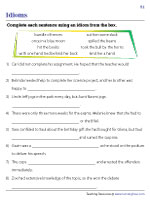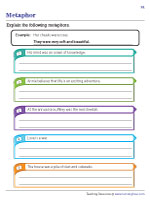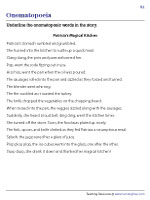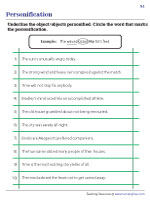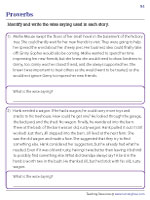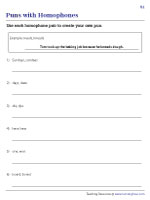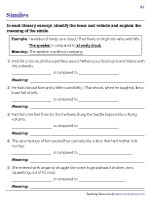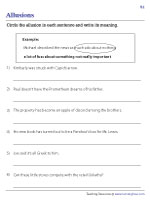7th Grade Figurative Language Worksheets
Get back into the swing of things with our free, printable 7th grade figurative language worksheets and boast a crackerjack knowledge of figures of speech such as idioms, analogies, allusions, and hyperbole, allowing your writing to shine at its most effective and most persuasive.
Select Grade 7 ELA Worksheets by Topic
Explore Seventh Grade Figurative Language Worksheets
Completing Sentences Choosing from the Idioms
If the kid reads each scenario carefully and combs through the idioms to pick one that fits, they'll be able to answer this exercise with one hand tied behind their back.

Don't just task kids with writing the meaning of each metaphor here, but instruct that metaphors show one thing is another, transferring all kinds of connotations, associations, and connections.

Identifying Onomatopoeic Words in Stories
Each story in our 7th grade figurative language worksheets harnesses the onomatopoeic effect to create vivid imagery without being verbose, making underlining the sound words in them fun for kids.

Completing Sentences Using Given Oxymorons
Fall in love with phrases that combine two words that seem to be the opposite of each other as you choose from the oxymorons given and complete these sentences.

Recognizing Personification and Personified Objects
It's important for kids to underline the thing that's given a human attribute; they must also circle the word that sparks the process of personifying.

Identifying Wise Sayings in Stories
The stories in our 7th grade figurative language worksheets leave kids with a saying expressing a general truth about people or the world; the job is for kids to identify and write this.

As you pair up the homophones to make puns in our 7th grade figurative language worksheets, enjoy how both meanings of the ambiguous words are true at the same time.

Identifying Key Components of Similes and Explaining Them
As you read these literary excerpts containing similes, first figure out the tenor and the vehicle in each, before you write a short explanation about the meaning of the simile.

Identifying Allusions and Writing Their Meanings
Writers owe a debt of gratitude to allusions; it’s your turn to express how thankful you are by circling the allusions and writing their meanings.

Completing Analogies Using Given Words
Great people use analogies all the time; so should you. This section, where kids choose from the words given and complete analogies, underscores why analogies matter.


 Interactive Worksheets
Interactive Worksheets Worksheets by Grade
Worksheets by Grade Grammar
Grammar Vocabulary
Vocabulary Figurative Language
Figurative Language Phonics
Phonics Reading Comprehension
Reading Comprehension Reading and Writing
Reading and Writing
